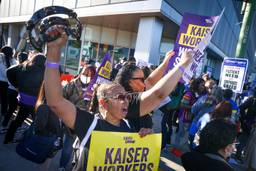TORONTO — After a bitter strike by nickel miners in Sudbury, Ontario, the Brazilian mining company Vale last year instituted a brand new safety policy, according to miners speaking at a conference in Toronto on Saturday.
It was based on a premise that has become increasingly popular among multi-national companies and smaller employers in North America and globally in recent decades: behavior-based safety programs, which analyze workers’ exact movements, behaviors and attitudes to find out what factors, in the company’s view, are causing accidents and injuries.
Union leaders and other critics have dubbed the programs “blame the worker,” on the premise that rather than addressing unsafe workplace conditions or inherently hazardous and grueling aspects of many jobs, employers say that accidents and injuries are almost entirely the result of worker behaviors and mindsets.
“A guy broke his leg on a broken stair, and instead of fixing the stair they disciplined him for not seeing the broken stair,” said Jamie West, a Sudbury miner and member of the United Steelworkers, at the Mining Injustice conference covering mining-related labor, environmental and human rights issues in Canada and globally.
Companies and consultants that advocate such programs say it is a way to involve workers in promoting safety and reducing injuries and accidents. Critics say it is a way for companies to shirk responsibility, discipline workers for safety lapses and discourage workers from reporting injuries.
The Steelworkers have published papers about “blame the worker” programs and taken a leading role in opposing the practice.
On Workers Memorial Day—the 40th anniversary of the Occupational Safety and Health Administration (OSHA) — on April 28, Teamsters Local 705 in Chicago launched a campaign to, in union lawyer Anthony Prince’s words, “eliminate the blame the worker” approach at UPS hubs in the Chicago area.
Behavior-based safety programs are considered to have originated with insurance investigator H.W. Heinrich in the 1930s. Labor experts and union leaders say these programs have in recent decades become part of a larger cultural and economic trend in the labor market, wherein workers’ protections are eroded under the guise of giving them more autonomy or individual responsibility.
Robert Bruno is an employment relations professor at the University of Illinois at Chicago and author of the 2003 book “Reforming the Chicago Teamsters: The Story of Local 705.”
He sees behavior-based safety programs as part of the general shift to a neoliberal economy.
These things have been around for a long time, but now this behavior-based model or approach to understanding what made a job safe or unsafe is really part of the package of anti-regulatory free market measures that have been on the march since the Reagan years…and the deregulation of the workplace or of the marketplace.
It’s part of a much larger political movement to take responsibility and obligation off the employer and shift it to the individual. Instead of having defined benefit plans, you shift the retirement benefit to the worker. You try to undo social security and turn it into a voucher system, where workers invest their own income. It’s the idea that you’re an individual and if you’ve got talent or skill you don’t need a union.
A 2000 story in the Multinational Monitor says:
The theory underlying these programs is that workers who work carefully do not get injured (and therefore deserve rewards), and those who work carelessly and become injured deserve punishment … Critics say the real goal of these programs is to discourage worker reports of injury and illness. Discouraging injury reporting can be hazardous. Workers may not get the care and early treatment they need, and job hazards may not be identified and corrected.
Teamsters Local 705 union leaders and workers say the highly physical nature of UPS work is bound to cause injuries, and the most meaningful way to reduce the risk is by reducing the amount of work employees are expected to do each shift. UPS officials note that their reported injury rates are below the national average for the courier and messenger injury. Prince said:
‘Blame the worker’ allows UPS to avoid genuine identification and elimination of hazards and injuries caused by management’s speedup and overwork of our members.
Behavior-based safety programs often celebrate and offer incentives — from gift drawings to free meals to clothing to cash — for number of days without OSHA reportable injuries. Critics say this brings peer pressure into the equation, with workers afraid of spoiling the group rewards and recognition for their colleagues. At the Toronto mining conference, Federico Veronesi, a Brazilian organizer involved with a contentious Vale mine, described this approach being used.
Miners work in teams of 10-12, and every team at end of month receives food for their family — rice and beans. But if one person gets injured in that month, no one gets the benefit.
Prince and other Teamsters Local 705 workers and members said that this tactic pits workers against each other and is also demeaning. Prince said:
It’s like we would have had a pizza party, but Tommy didn’t put his crayons away.

I hope you found this article important. Before you leave, I want to ask you to consider supporting our work with a donation. In These Times needs readers like you to help sustain our mission. We don’t depend on—or want—corporate advertising or deep-pocketed billionaires to fund our journalism. We’re supported by you, the reader, so we can focus on covering the issues that matter most to the progressive movement without fear or compromise.
Our work isn’t hidden behind a paywall because of people like you who support our journalism. We want to keep it that way. If you value the work we do and the movements we cover, please consider donating to In These Times.
Kari Lydersen is a Chicago-based journalist, author and assistant professor at Northwestern University, where she leads the investigative specialization at the Medill School of Journalism, Media, Integrated Marketing Communications. Her books include Mayor 1%: Rahm Emanuel and the Rise of Chicago’s 99%.







